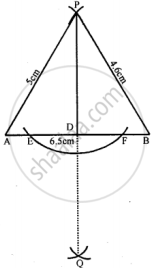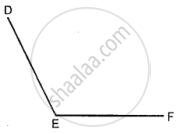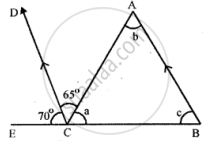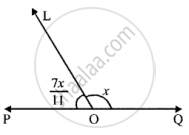Advertisements
Advertisements
Question
Draw a line segment AB = 6.5 cm. Locate a point P that is 5 cm from A and 4.6 cm from B. Through the point P, draw a perpendicular on to the line segment AB.
Solution

Steps of Construction:
(i) Draw a line segment AB =6.5cm
(ii) With centre A and radius 5 cm, draw an arc and with centre B and radius 4.6 cm, draw another arc which intersects the first arc at P. Then P is the required point.
(iii) With centre A and a suitable radius, draw an arc which intersect AB at E and F.
(iv) With centres, E and F and radius greater than half of EF, draw the arcs which intersect each other at Q.
(v) Join PQ which intersect AB at D. Then PD is perpendicular to AB.
APPEARS IN
RELATED QUESTIONS
In your note-book copy the following angle using ruler and a pair compass only.

Construct the 60° angle, using ruler and a pair of compass only.
Construct the 30° angle, using ruler and a pair of compass only.
Construct the 135° angle, using ruler and a pair of compass only.
Draw line AB = 6 cm. Construct angle ABC = 60°. Then draw the bisector of angle ABC.
Draw a line segment PQ = 8cm. Construct the perpendicular bisector of the line segment PQ. Let the perpendicular bisector drawn meet PQ at point R. Measure the lengths of PR and QR. Is PR = QR?
In the following figure, BA is parallel to CD. Find the angles a, b and c:

Two straight lines are cut by a transversal so that the co-interior angles are equal. What must be the measure of each interior angle to make the straight lines parallel to each other?
In the case given below, find the value of x so that POQ is straight line

Without using set squares, construct angle ABC = 60° in which AB = BC = 5 cm. Join A and C and measure the length of AC.
